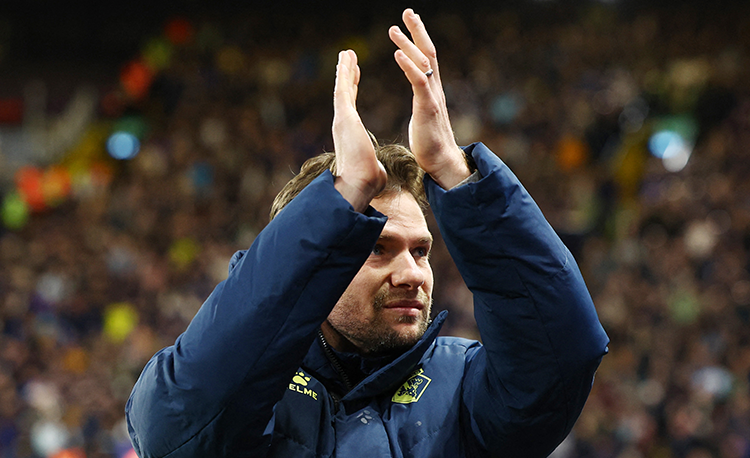Switching play
The main aim of this session is to encourage players to attempt to exploit space with overloads and speed. It also helps the players to recognise where and when to switch play effectively, as well as rehearsing the defensive structure that the team needs when playing against a side that makes good use of switches of play.
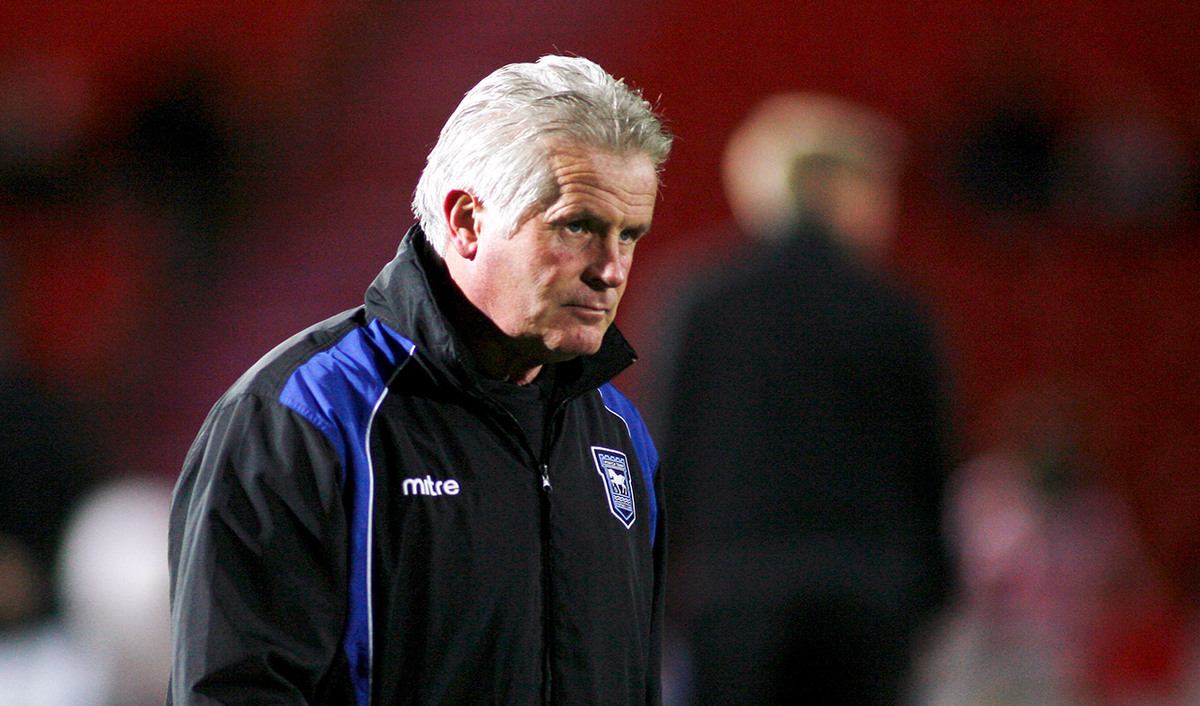
| Area | Up to full pitch |
| Equipment | Balls, bibs, cones, poles, 2 mini target goals, 2 goals |
| No. of Players | 20 players + 2 goalkeepers |
| Session Time |
Switching play practice: 20mins, Progression 1: 20mins, Progression 2: 20mins, Game: 20mins |
The main aim of this session is to encourage players to attempt to exploit space with overloads and speed. It also helps the players to recognise where and when to switch play effectively, as well as rehearsing the defensive structure that the team needs when playing against a side that makes good use of switches of play.
Individual skills are important to the session, so we will encourage players to show they know how to protect the ball when under pressure and also how, and more importantly, when to pass the ball. In addition to this, players will need to show good skills in 1v1s.
This session can be very challenging because the physical load is high, but if we break it down it tends to help the players recover.
SWITCHING PLAY PRACTICE
We set up between the penalty areas, using the full width of the pitch. We divide the playing area into five length-wise channels to help players recognise the different spaces. We position pole gates at both ends of the outside channels. To begin with we are using 18 outfield players split into two teams of nine.
This 9v9 starts with a ball served into the playing area by the coach. The possession team should pass the ball initially in tight areas while looking for opportunities to switch the play into the wide channels, where players can score points by dribbling through the pole gates, as shown [1]. When a team is in possession, we encourage its players to occupy all five channels if possible. When a team is out of possession, its players should try to occupy either three or four out of the five channels.
1
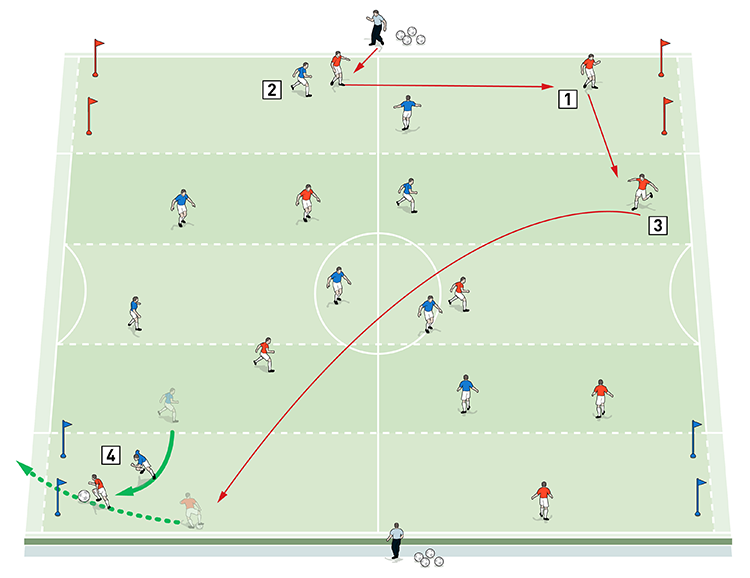
2. The out-of-possession team should try to occupy three or four of the channels and should attempt to regain the ball quickly
3. The possession team should look to create opportunities to open up and exploit the spaces on the other side of the pitch by switching play
4. Teams score points when players run through the wide gates with the ball, which makes it vital for the attacking team to switch play quickly and create overloads in wide areas
Depending on how the players respond to the practice, we can challenge and condition the teams accordingly.
PROGRESSION 1
We set up as before but now we add goals in their usual positions at each end, creating an 18-yard end zone in front of each goal. Play continues initially as an unopposed 9v9 as before, with the possession team passing the ball in tight areas until finding an opening to switch the play into the wide channels. However, now the aim is for the wide player to dribble through the pole gate and cross into the penalty area, where one attacker can make an unopposed run into the box to meet the cross and score in the empty net [not shown].
We progress this further, by adding an extra outfield player and a goalkeeper to each team, making it 11v11. One attacker is still allowed to make a run into the box to finish from the cross, but now he is opposed by a goalkeeper, as shown [2].
2
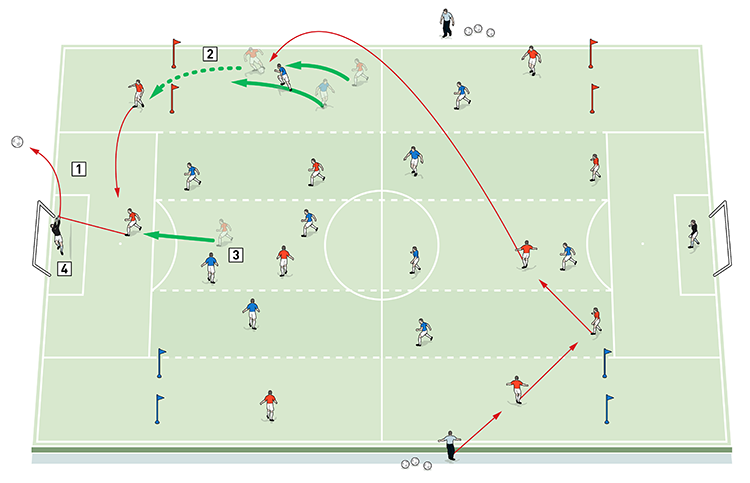
2. The aim is to switch the play to a wide player, who dribbles through the pole gate and crosses into the penalty area
3. One attacker can make an unopposed run into the box to meet the cross and finish with a shot on goal
4. After first running it unopposed, add a keeper and an outfield player to each team to make it 11v11, as shown here. Progress further by allowing up to two defenders to recover into the penalty area to defend the cross
We can progress this further by allowing two opposition defenders to enter the penalty area to defend against the cross [not shown].
PROGRESSION 2
We set up as before but now we also add a small target goal on each side of the pitch. This gives the team in possession the incentive to switch the play quicker and if they score in the target goal, a coach next to that goal can feed a second ball in to the winger in the same channel to continue the attack as before. The wide player receives from the coach, dribbles through the pole gate and crosses for a striker to run onto, as shown [3]. This means, if they are quick enough, a team can score two goals in the same attack.
3
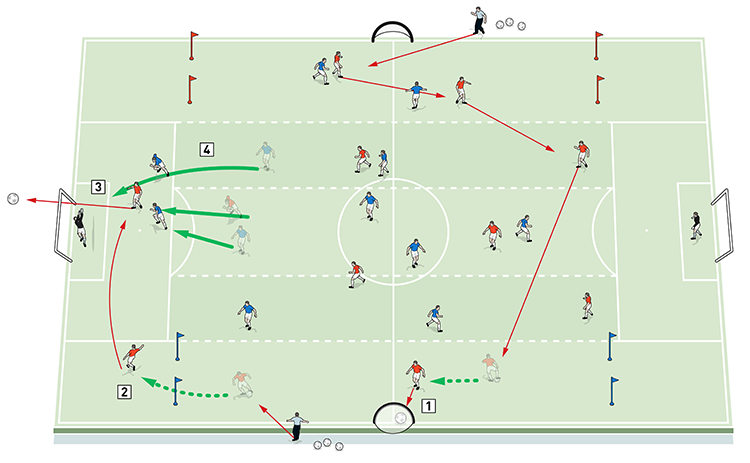
2. If the possession team score in the target goal, a coach feeds a second ball to their wide player, who dribbles through the gate and crosses
3. A forward meets the cross and the team scores a second goal in the same attacking move
4. Allow defenders to make recovery runs into the penalty area to defend against the cross
We allow defenders to make recovery runs into the penalty area as they would in a normal game.
11v11 GAME
We set up just as before but now we’re playing an unconditioned 11v11 game, so we remove the pole gates. However, we leave the channel markings on the pitch to give the players a visual aid to show them where the space is on the pitch. This will help encourage them to implement what they’ve learnt in the session so far, by switching play quickly when the opportunity arises, as shown [4].
4

2. Encourage players to implement what they’ve learnt in the session. Here the attacking team switches the play quickly to the winger, who receives on the move and crosses
Editor's Picks
Attacking transitions
Deep runs in the final third
Using the goalkeeper in build-up play
Intensive boxes drill with goals
Penetrating the final third
Creating and finishing
My philosophy
Pressing initiation
Compact team movement
Coaches' Testimonials

Alan Pardew

Arsène Wenger

Brendan Rodgers

Carlos Carvalhal

José Mourinho

Jürgen Klopp

Pep Guardiola

Roy Hodgson

Sir Alex Ferguson

Steven Gerrard
Coaches' Testimonials

Gerald Kearney, Downtown Las Vegas Soccer Club

Paul Butler, Florida, USA

Rick Shields, Springboro, USA

Tony Green, Pierrefonds Titans, Quebec, Canada
Join the world's leading coaches and managers and discover for yourself one of the best kept secrets in coaching. No other training tool on the planet is written or read by the calibre of names you’ll find in Elite Soccer.
In a recent survey 92% of subscribers said Elite Soccer makes them more confident, 89% said it makes them a more effective coach and 91% said it makes them more inspired.
Get Monthly Inspiration
All the latest techniques and approaches
Since 2010 Elite Soccer has given subscribers exclusive insight into the training ground practices of the world’s best coaches. Published in partnership with the League Managers Association we have unparalleled access to the leading lights in the English leagues, as well as a host of international managers.
Elite Soccer exclusively features sessions written by the coaches themselves. There are no observed sessions and no sessions “in the style of”, just first-hand advice delivered direct to you from the coach.







